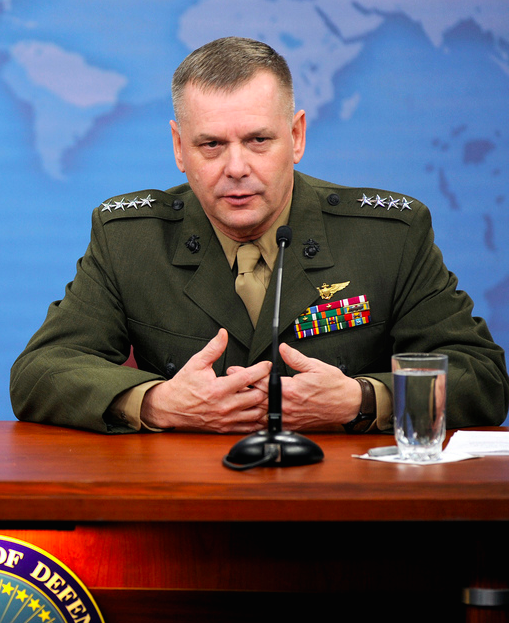
By Christina Bartzokis
Since U.S. forces invaded Afghanistan in 2001, and Iraq two years later, the U.S. military has grappled with the new and unforeseen challenges of modern warfare. Within the Pentagon, two primary schools of thought have emerged. One calls for increased interpersonal capabilities: the development of strategy to win the support of populations or promote multilateral cooperation with allied forces. The other advocates accelerated technological development in order to gain a competitive advantage over America’s adversaries. Four-star Marine Corps General James Cartwright falls into the second camp. The former Vice Chairman of the Joint Chiefs of Staff and Commander of U.S. Strategic Command spoke about “Innovation and the Modern Battlefield” last Tuesday.
In his talk, he stressed the role new technological development will play in the future of warfare. During the War on Terror, he explained, the Pentagon transitioned away from using industrial contractors to relying on technological development generated by universities, labs, and small businesses. The result, Gen. Cartwright posited, was greater adaptability: as opposed to the 20 year development of the F-35 fighter jet, most new technology had a very fast turnaround from concept to operationalization.

The other major innovation of the past 14 years of war was the birth of unmanned aerial vehicles, more commonly called drones. Manufacturing drones is much cheaper than manufacturing traditional aircraft. A single stealth bomber costs $ 500 million, while four drones together cost only $60 million. Additionally, drones eliminate the human limitations imposed on manned aircraft. For example, humans can survive only up to limited speeds in aircraft, but unmanned aircraft can exceed those boundaries. Unmanned aircraft can also remain airborne for around 24 hours, unimpeded by their pilots’ need to sleep or eat. Gen. Cartwright believes that the full possibilities generated by unmanned vehicles have yet to be realized, in part due to the generational divide within the Pentagon. He explained that the older generation of military officers, who occupy most major leadership roles, resist the idea of partnering with machines. In the future, Gen. Cartwright predicted, unmanned technology will proliferate air, land, and sea warfare.
However, Cartwright dedicated little time in his talk to the other change in modern warfare: the prioritization of interpersonal capabilities. With the adoption of counterinsurgency (COIN) during the wars in Iraq and Afghanistan, being able to establish mutual understanding with civilian populations became vital to military strategy. Similarly, the War on Terror outside of Iraq and Afghanistan has two components: targeted killings (via drone strikes) and multilateral cooperation with foreign militaries. The U.S. is now involved in training various militaries, through programs such as the Trans Saharan Counterterrorism Partnership, to conduct counterterrorism operations domestically.
If the technological development that Gen. Cartwright advocates is not tempered by similar growth in human relations proficiency, increased reliance on technology could hinder that sector of U.S. strategy. Especially if unmanned technology transitions into use in land warfare in the distant future, the absence of a human face for U.S. forces could curtain their ability to effectively establish a rapport with civilians.
To ensure the continued constructive interplay between human-centric strategy and technological advances, the military should ensure that unmanned craft supplement human soldiers in combat zones (especially occupation zones) but do not replace them. In the long term, the two theories of future strategy can combine to increase U.S. competitive advantage beyond what either could achieve independently.
Christina Bartzokis is a freshman in Jonathan Edwards College. She can be contacted at christina.bartzokis@yale.edu